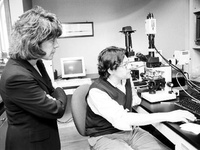“You get very enticed by the films of Pollock,” she says. “To really understand what he was doing we had to do it for ourselves.”
The results were a testament to Pollock’s genius beyond the mere technical means of creation—while the first few go-rounds looked “really beautiful,” according to Mancusi-Ungaro, by the third layer “it became a total mess.”
Her study became the celebrated article “Response as Dialogue.”
Preserving the Trust
Mancusi-Ungaro says she sees herself as only the latest in a long line of Harvard art experts.
“I do believe that my work is part of a large and important tradition at Harvard,” Mancusi-Ungaro says. “The culture of studying the physicality of a work of art started here, but Harvard hadn’t extended that study to modern art.”
She explains that the first professional art restorers were artists themselves.
Later, when museums increased the value of publicly displaying art, conservators began to gain the trust of artists as the anonymous preservers of their work for posterity.
The work is common on the paintings of Old Masters; most pre-20th century paintings in museums have had some kind of restoration done on them.
“Carol is somebody who is able to take a really informed, sensitive approach to conservation, to be cautious, to do the art historical homework, to talk to the artist and not necessarily to capitulate to the artist...but to be informed by whatever they can tell conservators,” Cooper says. “We’re very lucky to have her. She’s incredibly distinguished.”
Mancusi-Ungaro wants to see Harvard build on its success of conserving Old Masters and make Harvard the primary resource for conservators of modern art.
“That would be a wonderful goal, if the center became something that demonstrated the centrality of arts to our culture.”
—Staff writer J. Hale Russell can be reached at jrussell@fas.harvard.edu.









